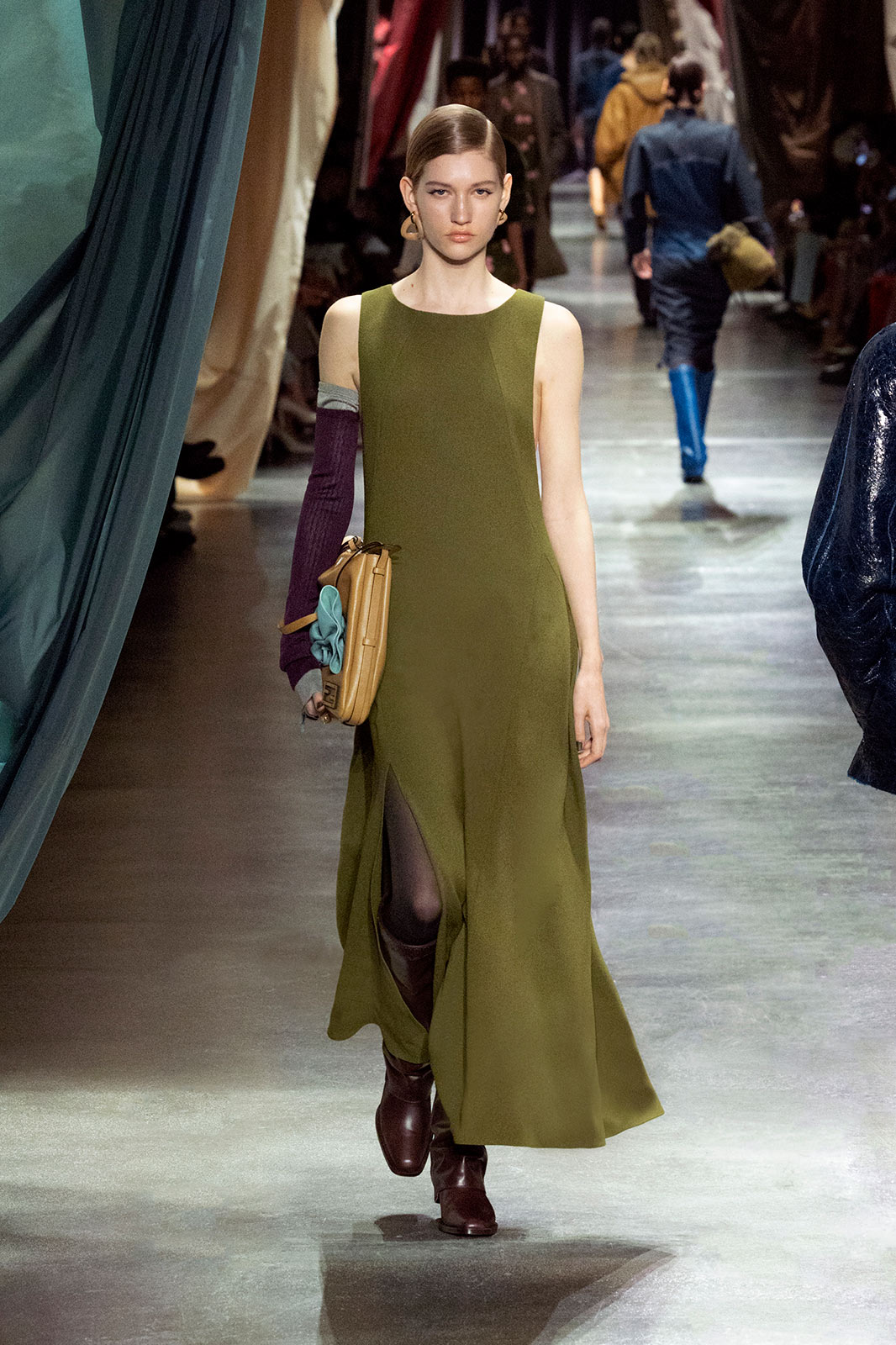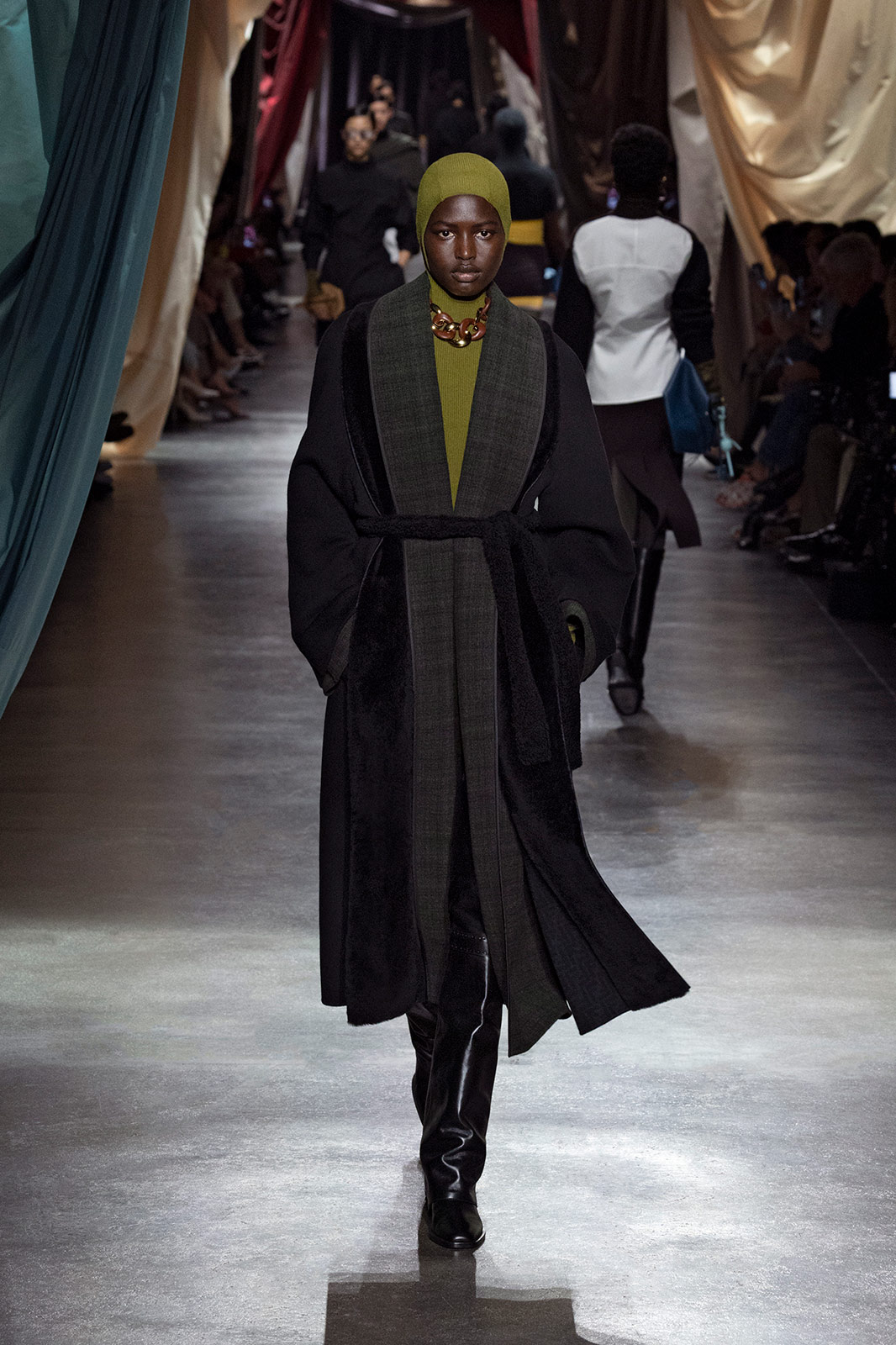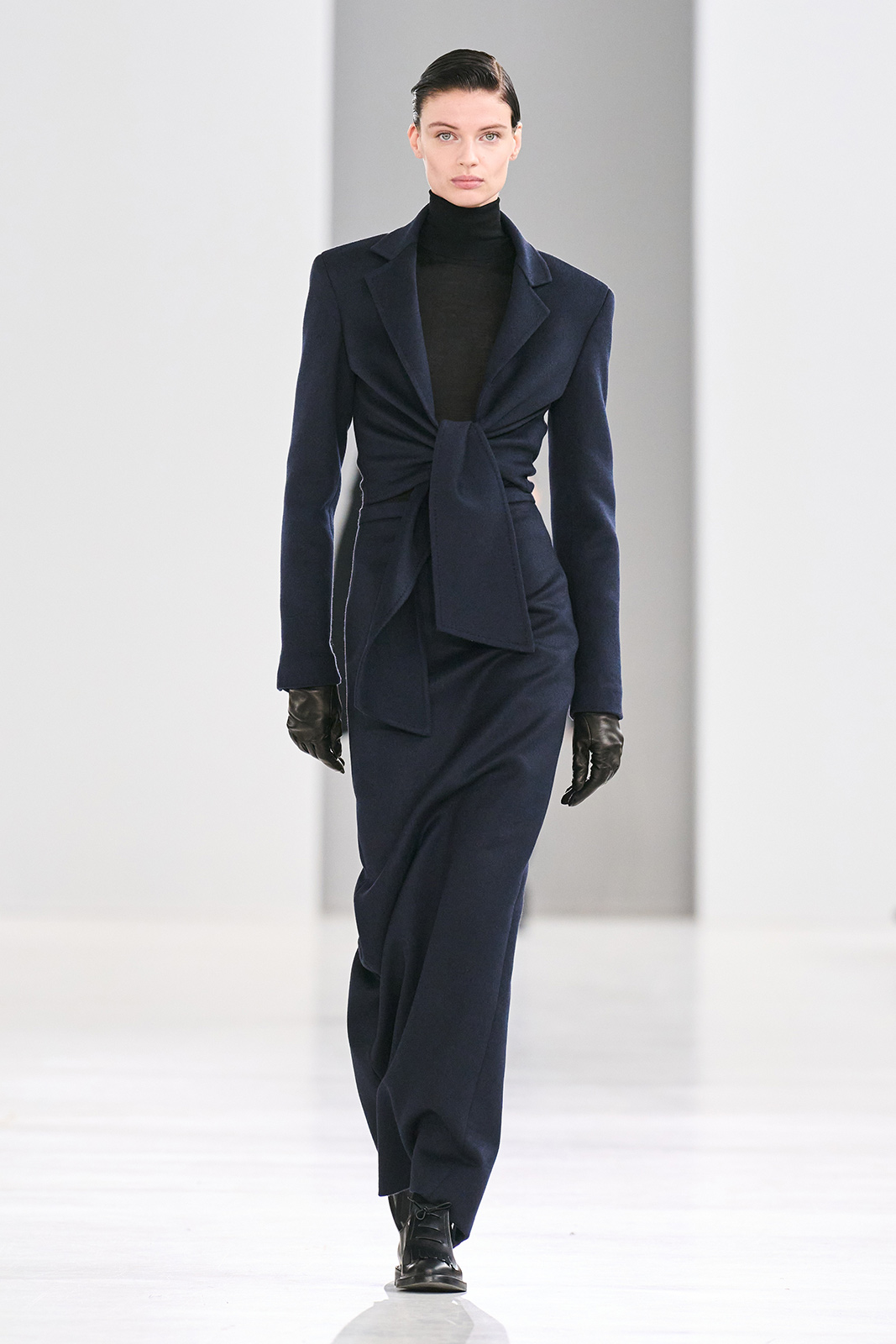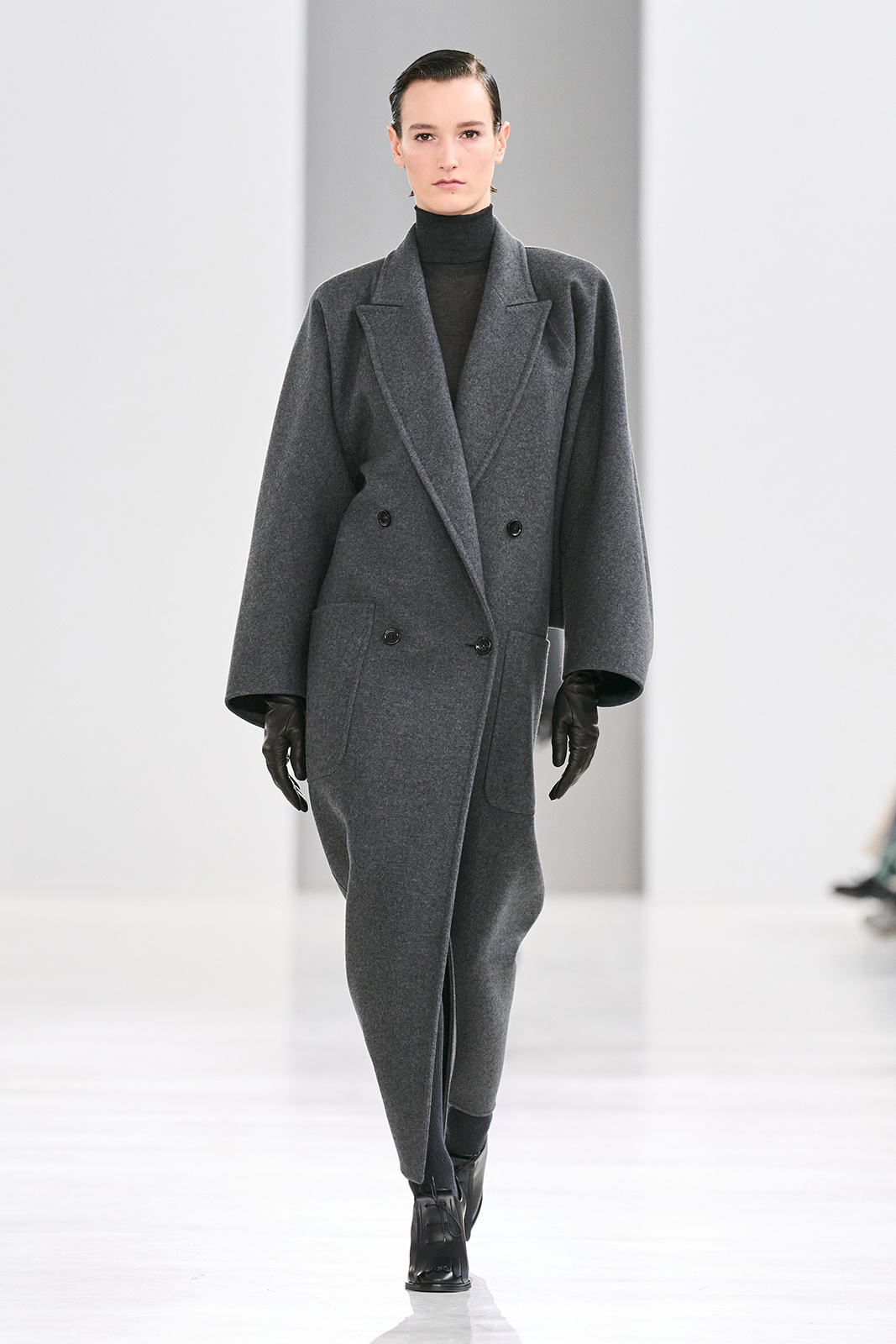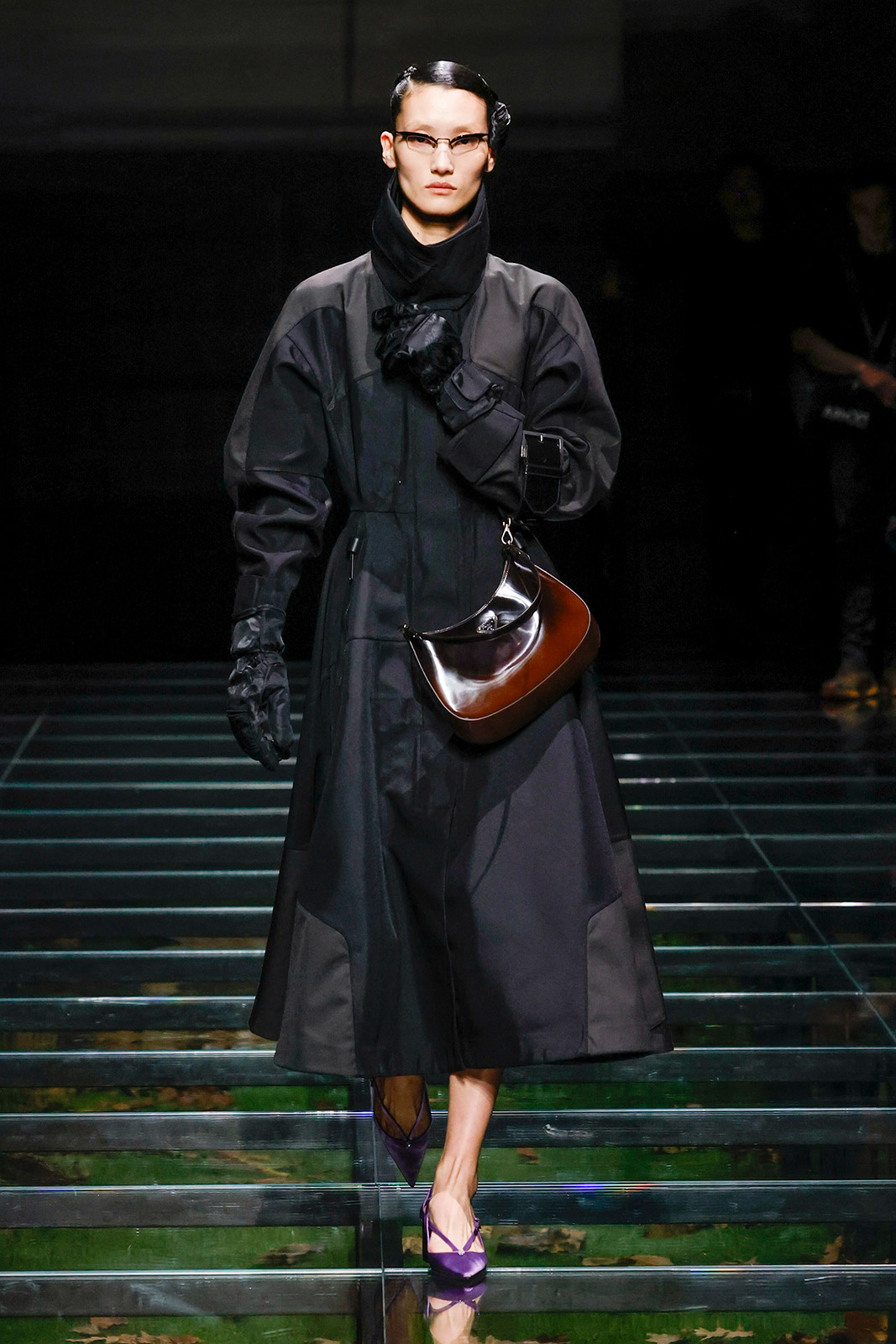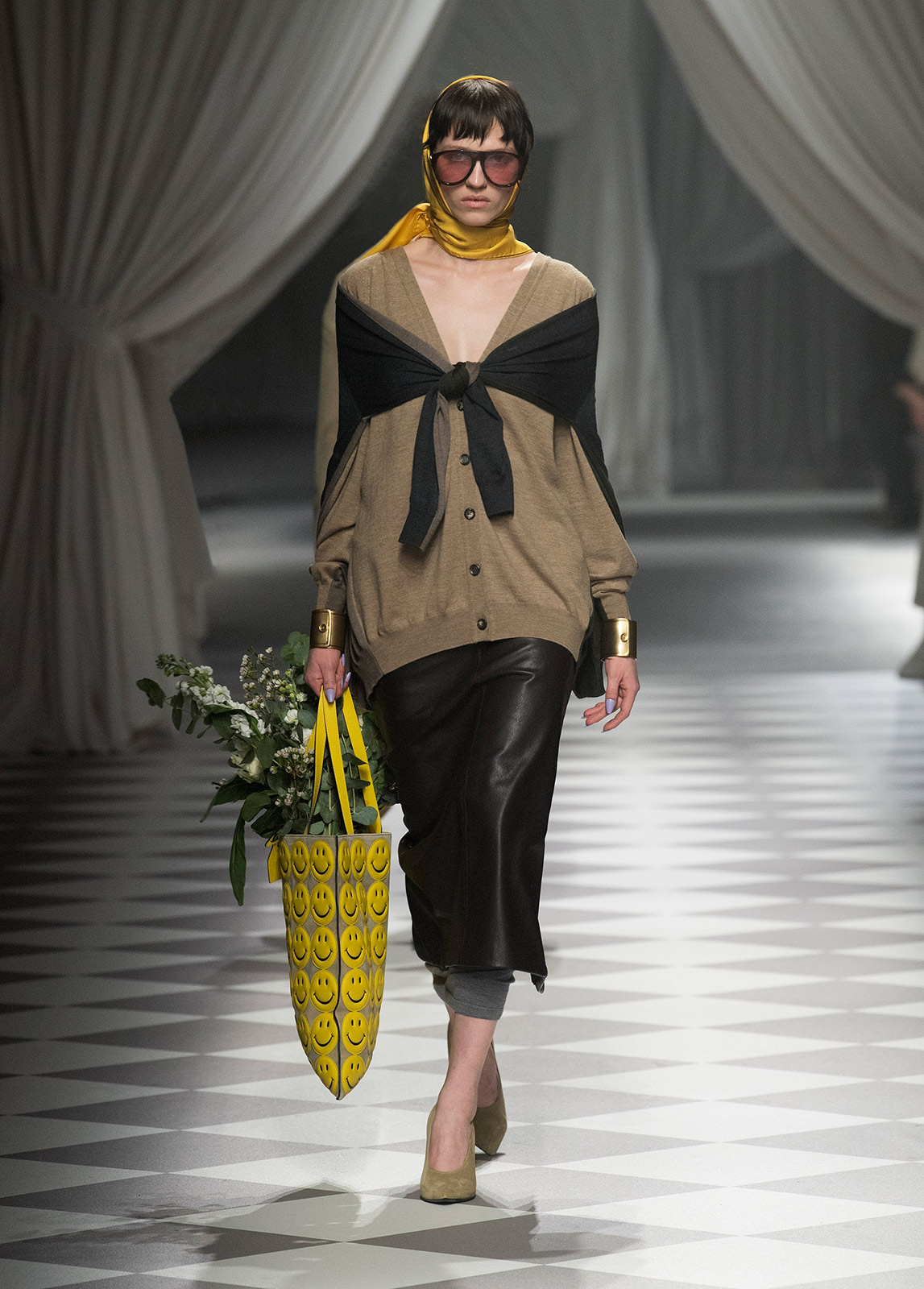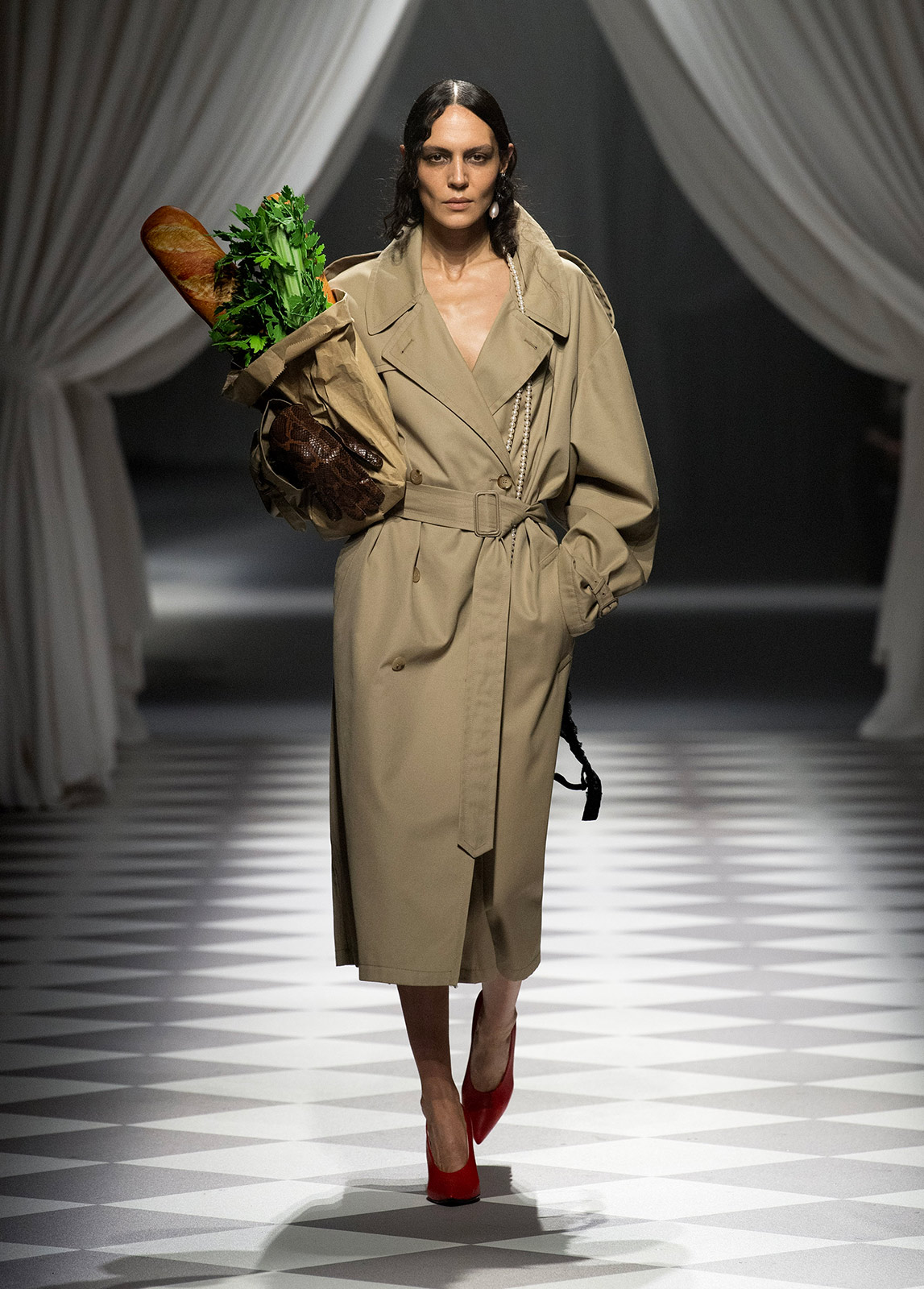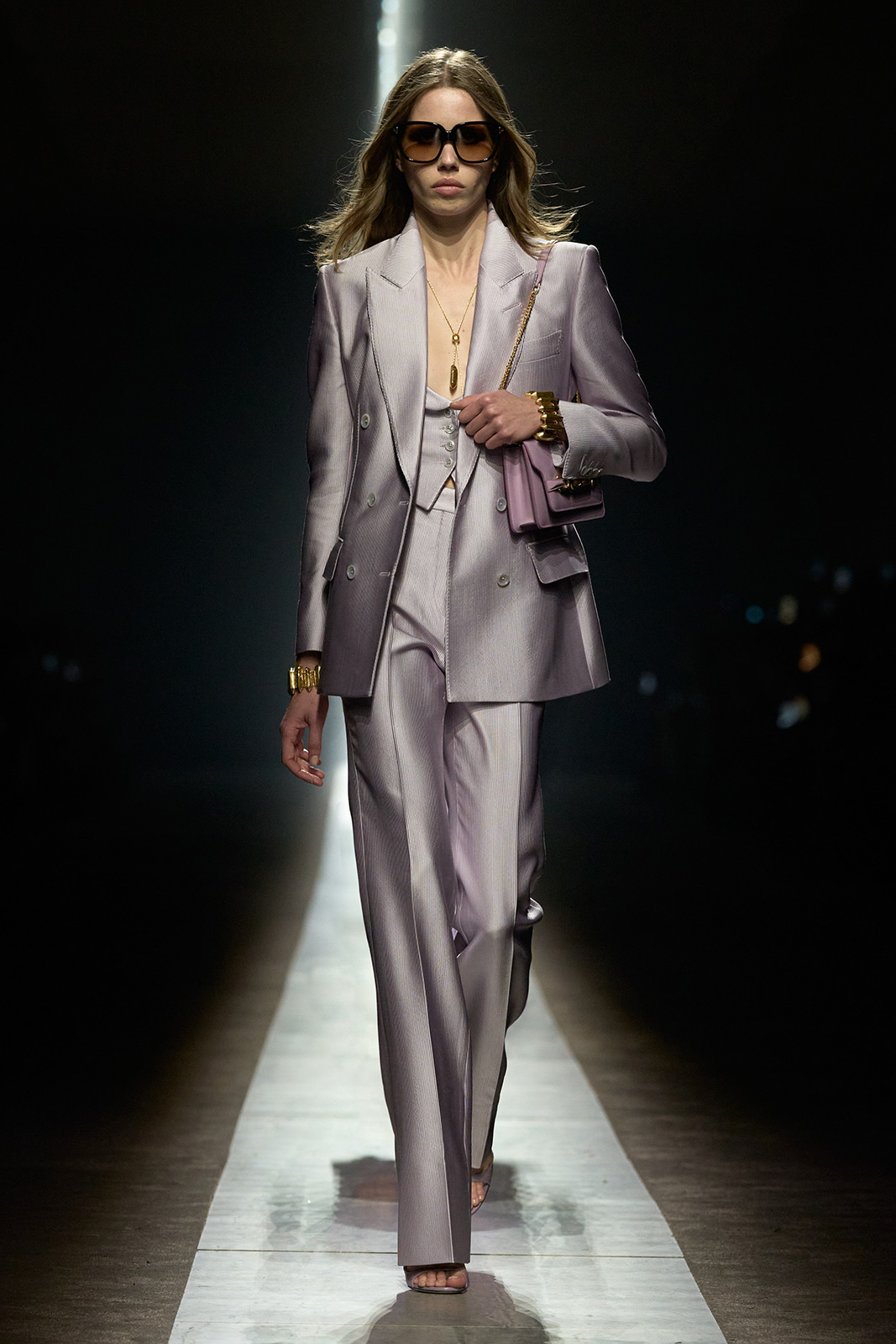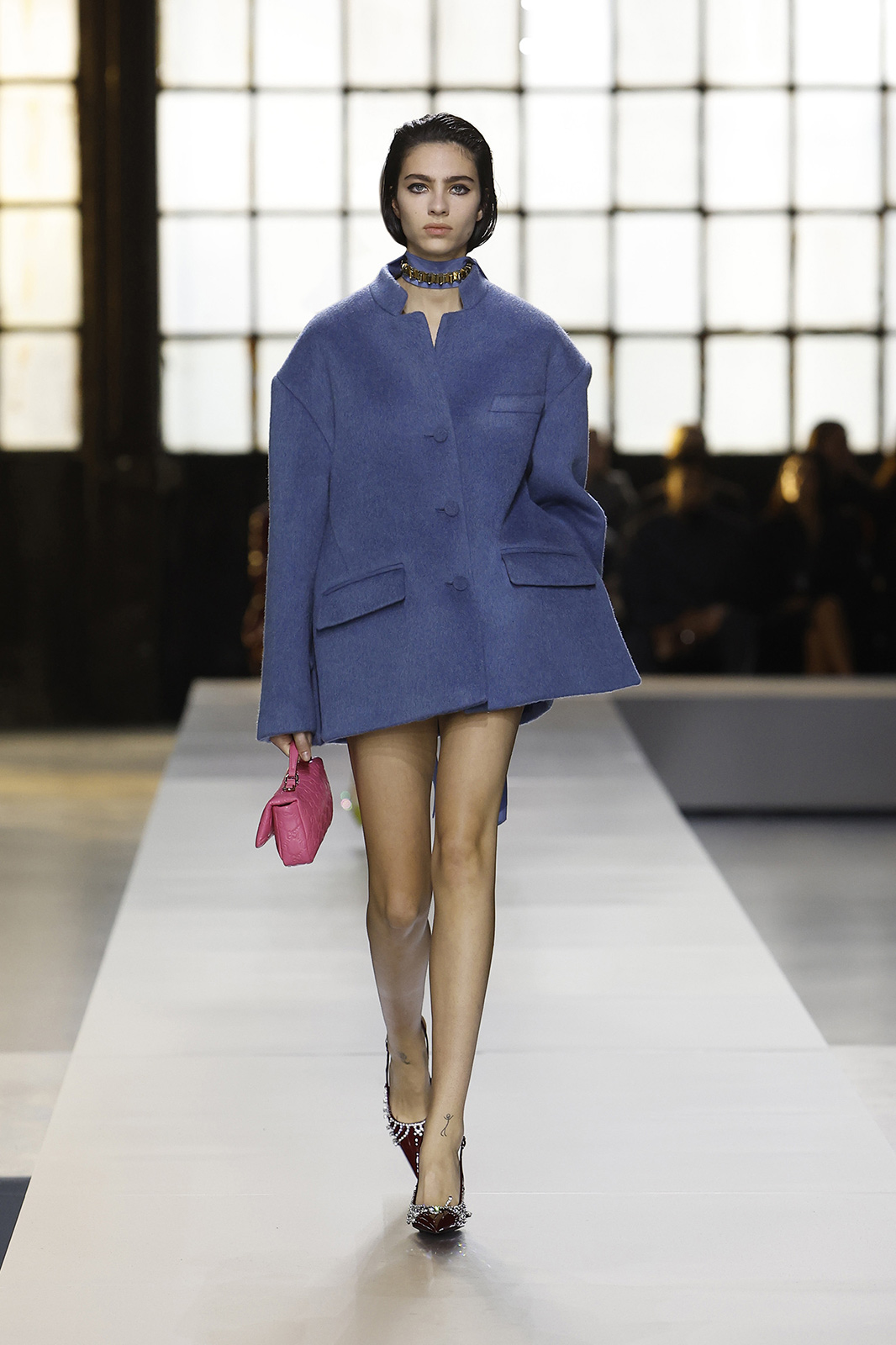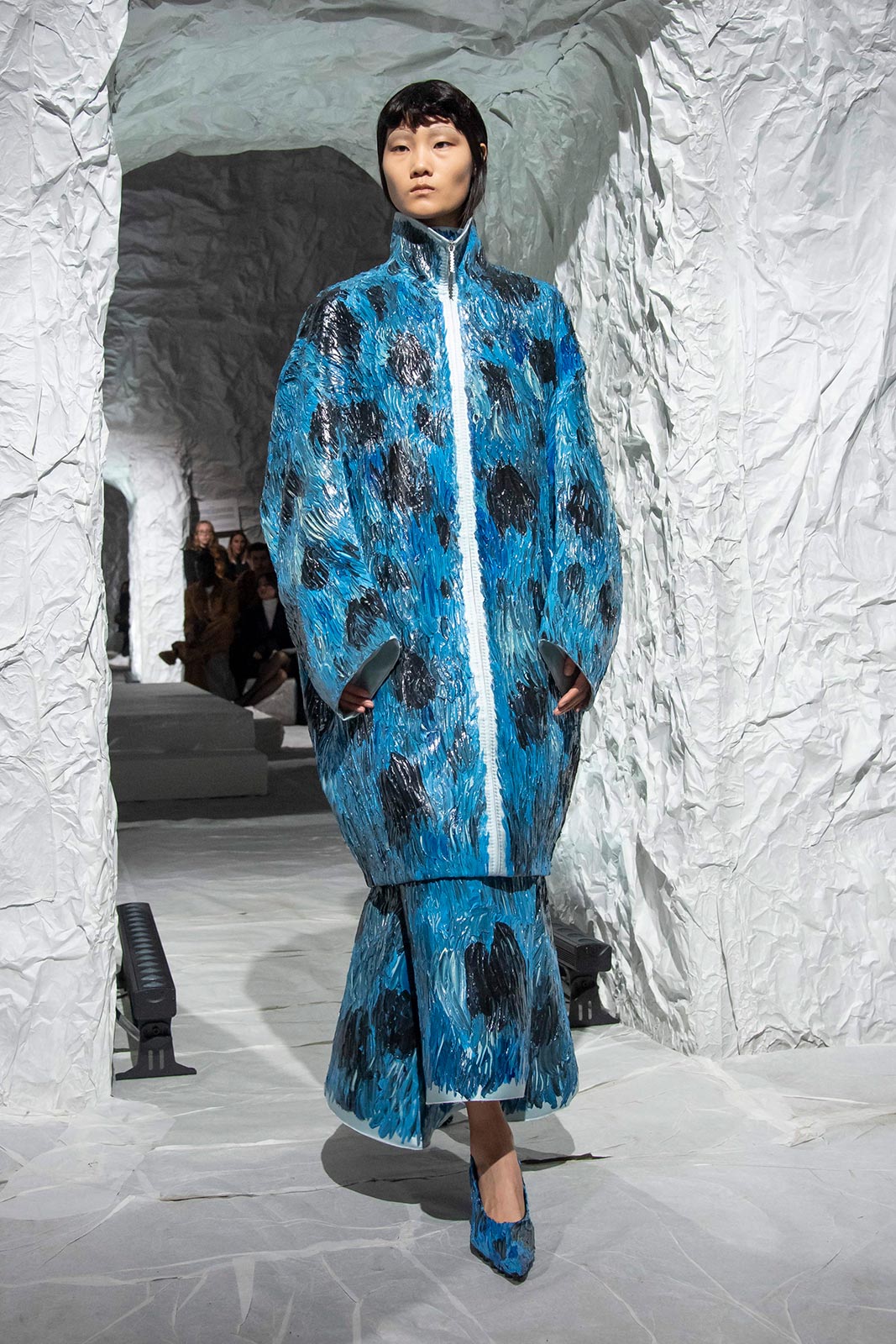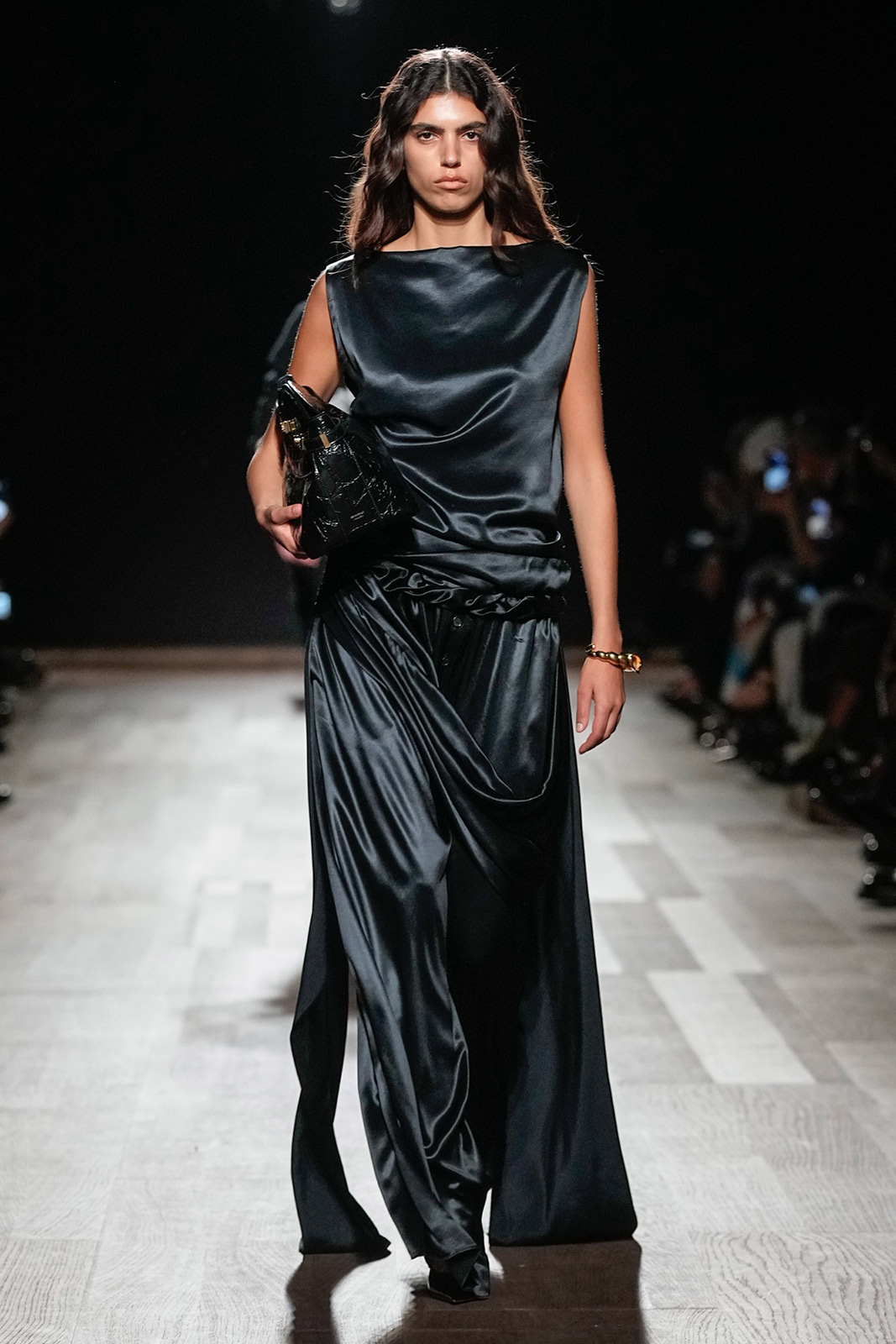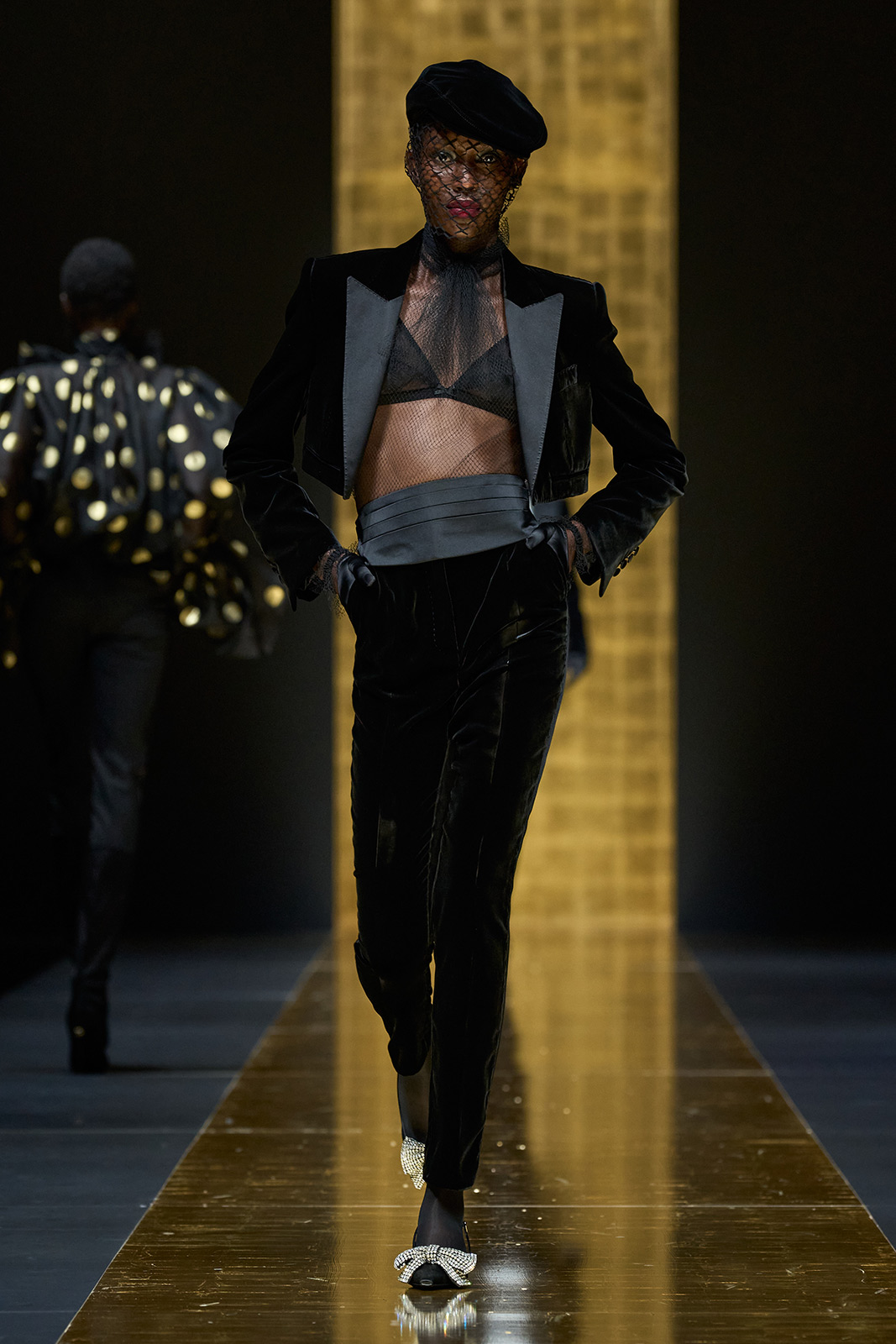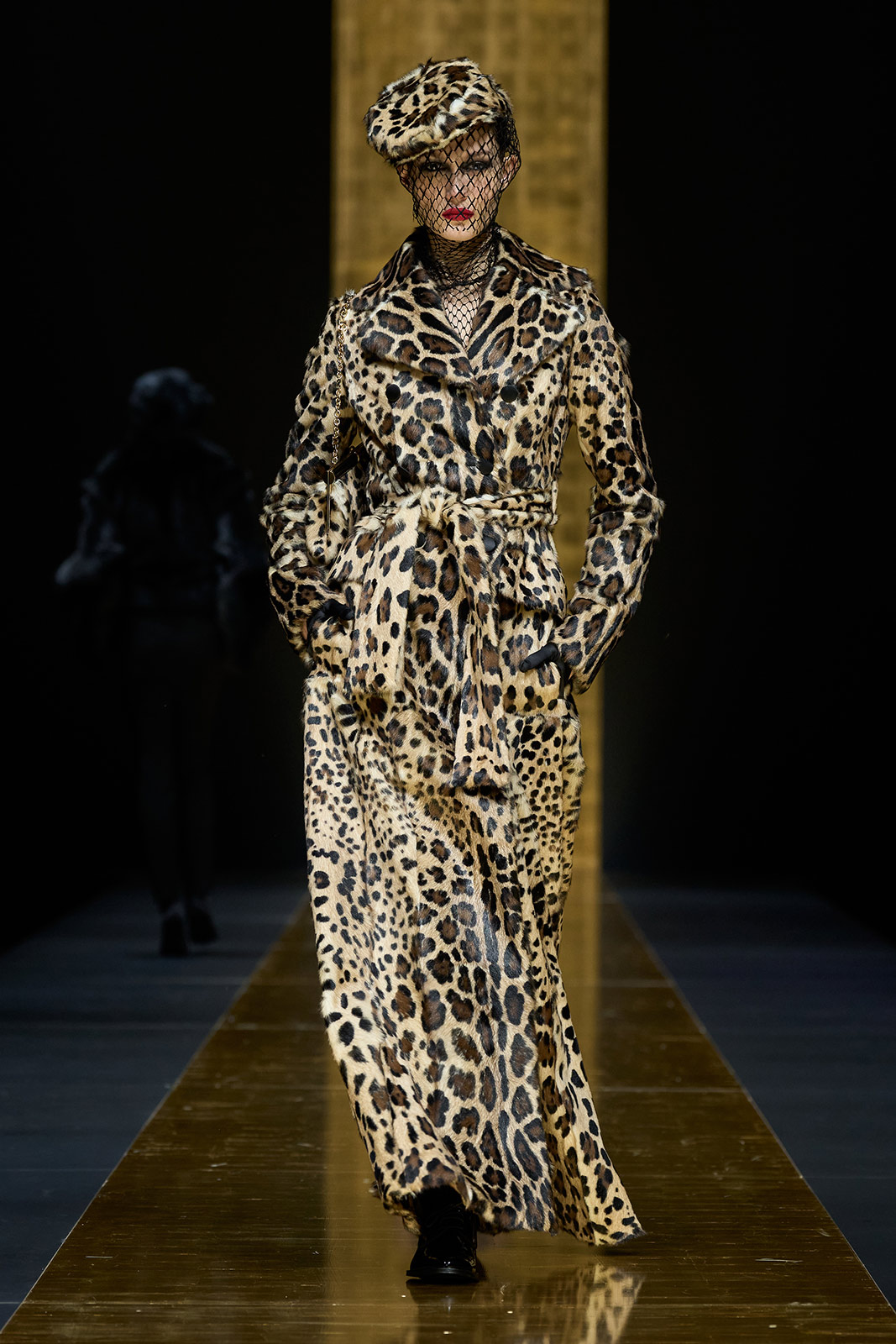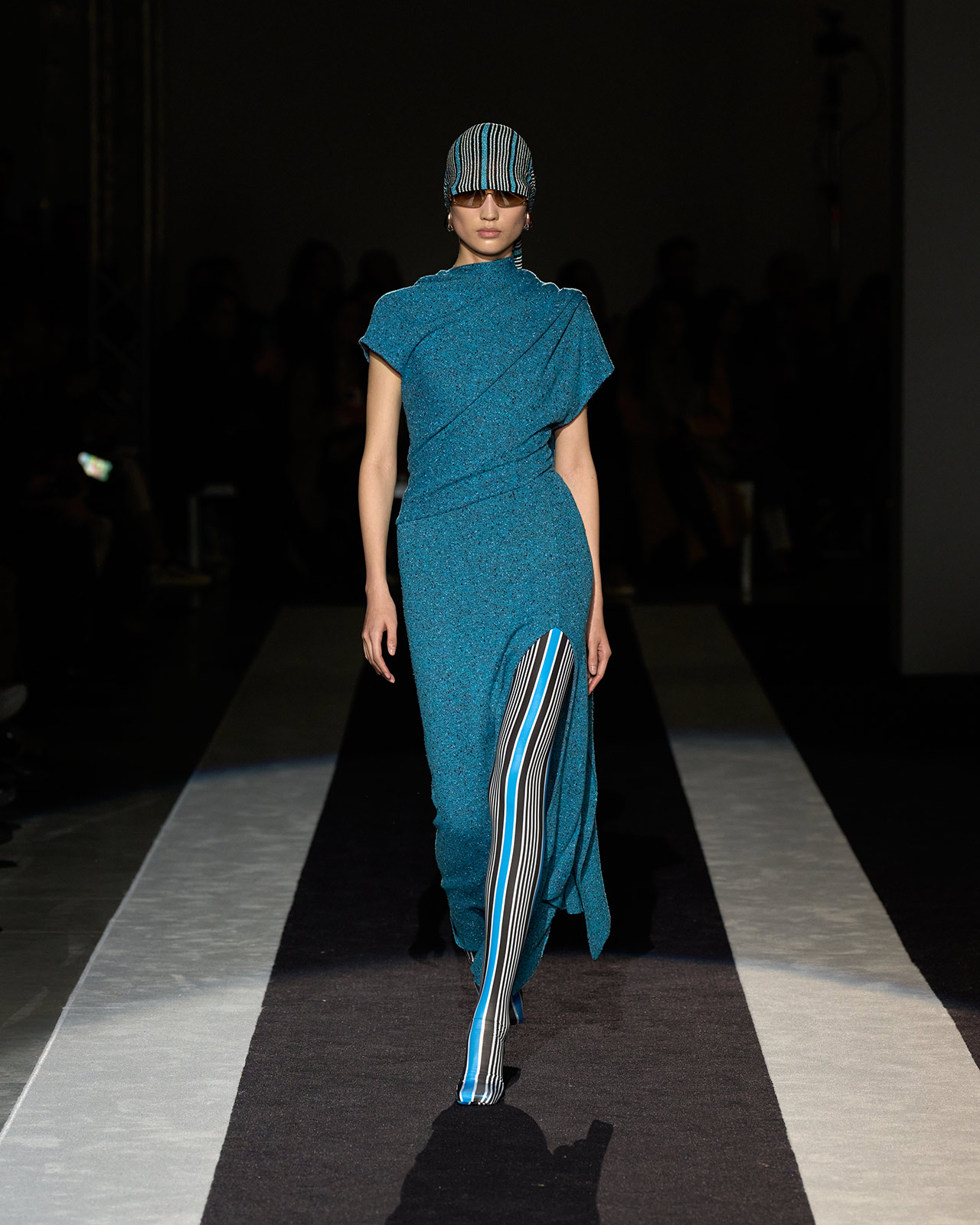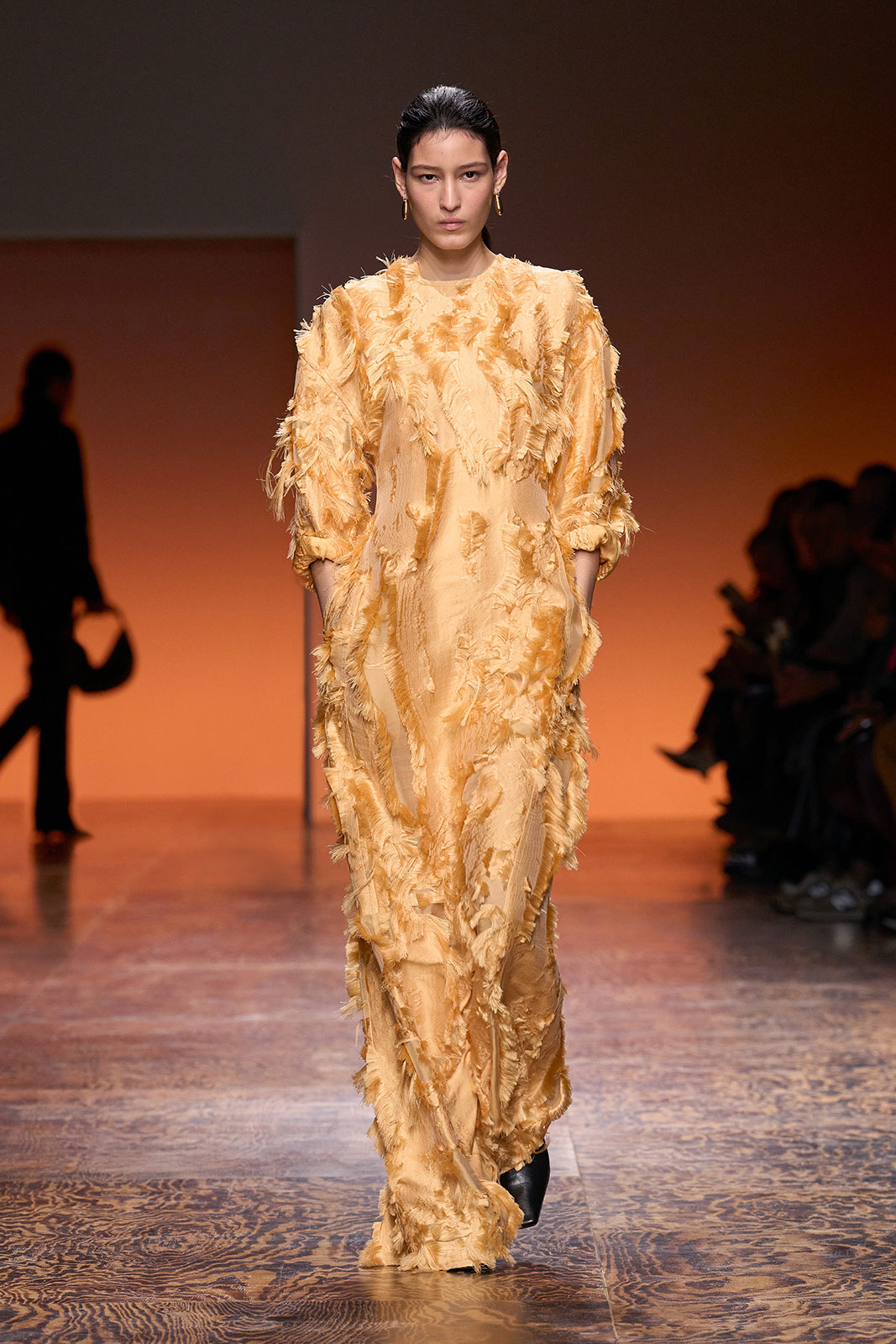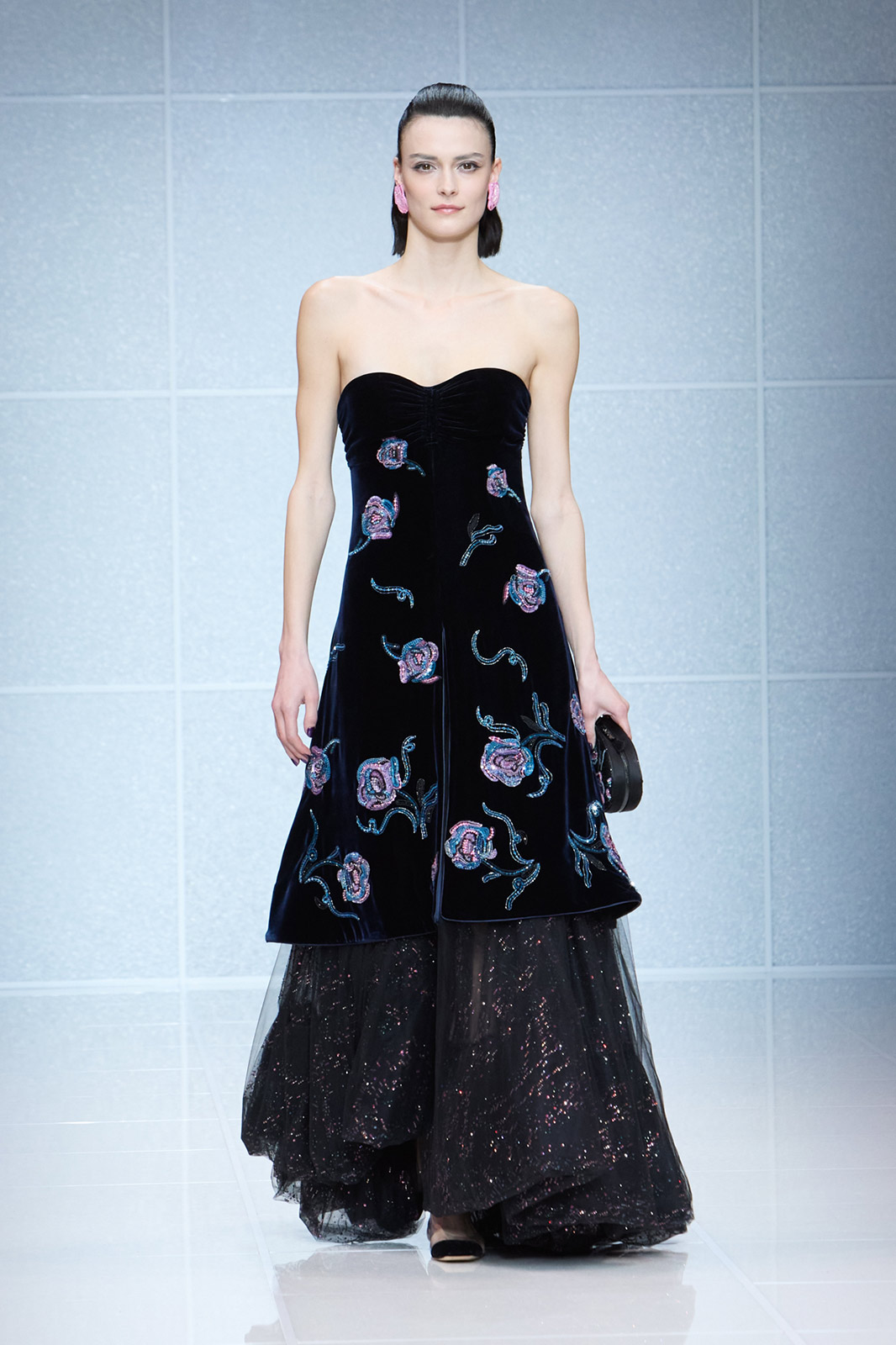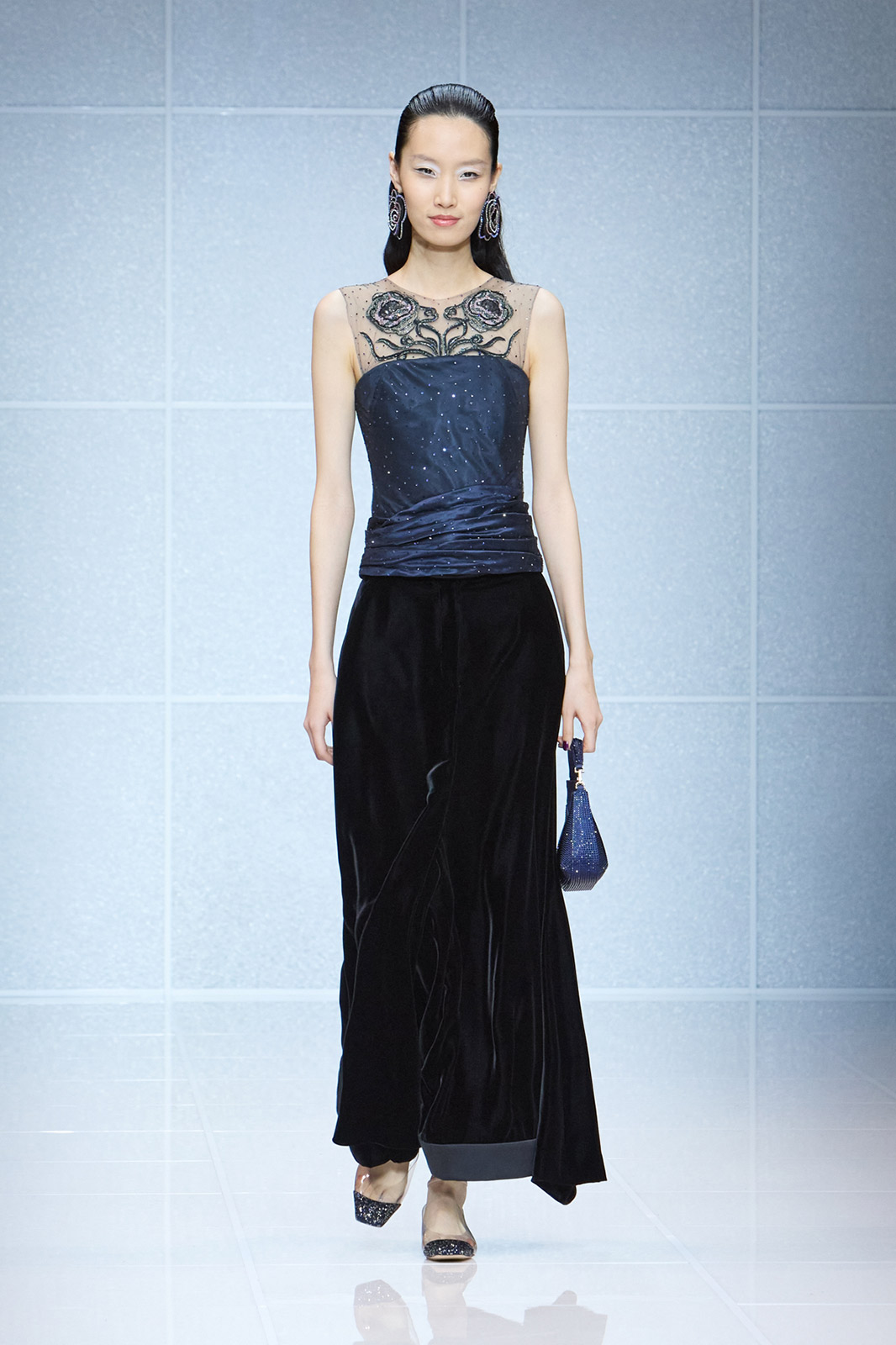The Document staff gathers the most captivating runway presentations from a week in Milan
There’s a fine line between passion and obsession. Fashion encourages a distinct kind of fixation: Does this dart work here? Is that button too large? Does that sleeve clash with the dress’s bias? A preoccupation with details is what makes a great collection, when that kind of radical focus emerges from measured desire, rather than compulsive beading, for example.
Milan’s Fall/Winter 2024 runways showed the uninhibited in the obsessive. Clothing was set by the kind of limits artists use when probing an idea (see: Picasso’s Blue Period). Prada, by the concept of the girlish bow; Missoni, by stripes; Marni, by isolation. What emanated from all of these hyper-attentive collections was a sense of unbridled freedom, though each was created under the constraints of a theme, and their house codes. Rules can be liberating when allowing for an unselfconscious form of editing: Monomaniacally rearranging a jacket’s buttons to the perfect distance makes for a good collection, inventing 64 different variations on a tuxedo (in Dolce & Gabbana’s case) makes for a great one.
Document rounds up the most engrossing runway shows from Milan’s Fall/Winter 2024 ready-to-wear season.
Fendi
2025 will be a major landmark for Fendi: 100 years since the house’s founding, and 60 years since a young talent named Karl Lagerfeld was hired to update their fur line. Lagerfeld’s inimitable influence set the house on the path creative director Kim Jones continues to follow. With next year’s centennial front of mind, Jones dug not only into Fendi’s extensive archive, but into the annals of his own variform influences. The very first look of the show referenced the designer’s longstanding affinity for traditional Japanese dress, in the form of a minimalist two-piece ash-toned suit, with a high mandarin collar and generously proportioned trousers. This particular kind of billowing elegance also had a couple of unusual bedfellows: British ’80s workwear and aristocratic selleria. A range of high-riding boots in mustard and mahogany lent a certain panache to every outfit they appeared with. Denim tops and skirts were two-toned, large-buttoned and clearly designed for functionality. The press release nods to Jones’s penchant for “blasé British style,” but this doesn’t do justice to the inventiveness the show displayed, from Ellie Grace Cumming’s nifty styling to the pulse of Mariah’s 1983 Japanese avant-pop record Shinzo no Tobira setting a shuffling rhythm to the proceedings. Fendi’s designs, according to Jones, are for the woman who “has something substantial to do. And she can have fun while doing it.”
Max Mara
The story of Max Mara has always been about a good coat—the perfect coat, even, which is as much a matter of warmth and protection as it is an agent of transformation. A great piece of outerwear can affect postures, poses, and perhaps attitudes also. There’s something sexy, too, about the fact that a coat is the first thing you take off and the last thing you put on, to open and close the door to desire, to leave someone wanting more. A Max Mara coat is all that and then some. This season, Ian Griffiths designed a collection of outerwear that ran the gamut from long and lean to short and cocoon-like, all with a discernible ease and lightness. A subtle zig-zagged seam lined the hem of a floor-length coat. There was a version of the raglan prominently featured, with a seam that ran down the shoulders and around the elbows, sometimes edged in leather, others piped with shiny, square-shaped jewels. Wide lapels were in abundance. Many of the looks were styled with a knitted band cinched at the waist by a thin belt, like an obi.
Griffiths’ muse was the 20th-century French novelist Colette, whose voluptuous prose often revolved around sexually liberated women. The inspiration didn’t surface here in literal ways. It was about a deeper sensuality, topped off with a fabulous coat.
Prada
There were two main takeaways from this season at Prada womenswear: hats are back, and girliness—at least in the traditional sense—is over. Miuccia Prada and Raf Simons presented their latest in Fondazione Prada, with a catwalk staged over what looked like a live terrarium of verdant algae. Models wore Prada staples (impeccably tailored chaste skirt suits that revealed just enough to maintain sex appeal; candy-colored satin kitten heels) perfectly alongside Raf Simons signatures (fashion-clunky black leather boots; leather so impeccably tailored it bordered on fetishistic). The designers joined forces in a deliciously freaky way, with chin-strapped headwear imagined in feathers and velvet, leather handbags with adjustable thick python wristlets, and sheer boxy shifts. These dresses were quite a humorous surprise from the designers, especially when rendered in blush pink or baby blue with bows stuck all over them. For two of fashion’s most serious designers, such a choice felt less topical than polemical. The collection notes confirm this impression: “clichés of femininity—bows, frills, ruffles—are reconsidered, their meaning fundamentally assessed. Why do they persist? Why do they attract?” Once again, Prada and Simons proved not only the strength of their design partnership, but the sartorial excellence that comes along with questioning tradition.
Moschino
Franco Moschino was something of a humorist; a knowing irony was his preferred tone. Adrian Appiolaza, the newest face of Franco’s eponymous luxury label, went back to the very beginning to inspire his first collection as creative director. The brand playfully calls it ‘Collezione 0.’ Taking from Franco’s eccentricity and fashionable sense of humor, Appiolaza worked with stylist Nunzio del Prete to create a collection that explored a handful of novel phrases firmly rooted in the Moschino lexicon. The designer’s take on the classics—suits emblazoned with the word “ciao,” double-denims faded to a dusty shade of steel-blue, thin ties left undone—was just subversive enough to be charming. Moschino has always surprised through improbable combinations: An oversized white t-shirt with “LOVE” printed on it in large black type was paired with an asymmetrical red skirt festooned with layered pleats. Appiolaza would later double down on this unpredictability sending simpler looks down the runway: A notch-lapelled black leather jacket, faded black jeans and a plain Moschino logo tee make one model look like a sexy Fellini character. The yellow smiley face, a symbol oft-seen in this collection, really is the trademark Moschino character. If Appiolaza promised anything for his next collezione, it’s unconventionality—but always with a smile.
Tom Ford
This season at Tom Ford was all about the senses. Peter Hawkings’s second collection at the label, based on the idea that “Beauty is an all-encompassing feeling,” as read the show notes, established the Tom Ford archetype from their clothing, to their sunglasses, to even their fragrance. Rich purples found their way into a sharp color palette of black, navy, and a varying palette of off-white, giving leathers and twill that extra oomph. One pale gold beaded dress was made entirely out of a latticed technique, splaying out into a swishy fringe that swayed as the leggy blonde model’s hips did. It was topped with a matching fur coat draped just around the shoulders, and accessorized with snakeskin strappy sandals, a coordinating clutch and massive round “don’t fuck with me” glasses. The Tom Ford brand of glamor is built on the slinkiness of a runway, like the black leather mock neck trench and matching pants look whose belt and clutch sported the same matching hardware: Coordination is not corny, it’s machinelike in its precision. The deftness of that idea was what Hawking meant with the idea of beauty as all-encompassing. From head to toe, anyone in a full Tom Ford look is the moment.
Gucci
“Seek a small subversive gesture.” This was Sabato De Sarno’s call to action in the collection notes for this Fall 2024 season. An admiration for the little things was apparent this season, the designer paying close attention to embellishments, footwear, and accessories whose details became increasingly more intricate the longer they were studied. Monochrome coats and cocktail dresses glittered with just slightly off-tone sequins and crystal fringe; there were in fact two versions of the horse riding boot that tricked the eye—a knee length and over-the-knee shaft—that looked like they magically grew and shrunk over the models’ thighs during the show. The handbag offerings were classic with a twist: a new GG-perforated nappa leather top handle bag with a bamboo handle joined the ranks among other favorite horse-bit hobos from the Gucci archive, along with a unique half circle-shaped patent leather pocketbook reminiscent of a crescent moon.
Looks in rich maroon and pea soup green alternated down the runway, perhaps an elevated nod to the opposite sides of the red-green color spectrum: When oscillating between the two colors viewers can produce what’s called an afterimage, or an impression of what they’ve just seen. Was this De Sarno’s goal—to get us to look a little bit beyond the Gucci iconography and into the design work?
Marni
“Para-essential” took a knife to the parasocial for Marni’s Francesco Risso. A term the designer used in the show notes, “para-essential” refers to the things we don’t need: “engines, planets, or, as Ms. Woolf would say, that very jar on the nerves, the thing itself before it has been made anything.” With that, Risso made a collection freeing himself and the Marni family (as he calls his team) from the shackles of reference images, worshiping false idols at the altar of social media trend forecasts, and the like.
Rissi found his flow state as a designer when tapping into his animal one. As he instructed his team when developing the collection, the walls and windows were covered in paper, a physical representation of the only reference allowed as a reference, this quote from Virginia Woolf: “If by chance you enter a paper cave, bring no clothes.” So, the runway was literally papered, and the clothes themselves were gestures toward Rissi and the Marni family’s pure, animalistic sense of creativity. From black mohair catsuits to stoles ostensibly made out of human hair, the referenceless-ess of the runway felt like looking at children’s wildest fashion drawings come to life. The crescendo of the show, however, was the final colorful looks, hand-painted in a way that made the models look like they had finished canvases tailored onto their bodies, texture and all. Perhaps the most stunning thing about Rissi’s latest is the level of consistency found within his process behind the clothing: in forcing out preconceived notions and reference images, he and his team were able to extend imagination into the real world of fashion. May society emerge from Marni’s cave with a new perspective.
Versace
At Versace, spiked hair and graphic liner suggested punk rock, an oft-revisited theme for designer Donatella Versace, the iconic platinum blonde perpetually clad in smoky leather with somehow smokier eye makeup. The collection was punk rock by way of a boarding-school bad girl this time round; a little grace, a lot of attitude. Fabrics were shredded and then woven into tweeds. Dainty white collars poked out of blouses with shoulder pads and puff sleeves, sometimes sheer, other times reflective with a black-on-black leopard print. A sweet twinset, paired with matching micro shorts, was peppered with black sequins.
This fall, sex was perhaps the thread that bound the Milan collections, and there was plenty of it at Versace. A cowl neck number came with a side slit that rose past the hip to the waistline. A floor-length gown flaunted nothing but chains of crystals, revealing a satin bra and panty set underneath. The most erotic, though, was the signature chainmail dresses, impossibly tight at the waist and round at the hips, which were draped with a swathe of pleated fabric. The effect was like that of cloths in Roman sculptures, liquid lines frozen in stone, firm and fluid in concert—just miraculous.
Ferragamo
A little less than a century after its founding, Salvatore Ferragamo’s eponymous brand’s Fall 2024 ready-to-wear collection sought to reflect, according to the show notes, “the self-expression of the ’20s—on both sides of the century.”
The lavishness and relative freedom of the roaring ’20s felt modern in their transformation, in pieces like completely sheer, billowing black and yellow dresses. Parallels were drawn between the industrial boom and modern workwear trends with pieces that resembled textured, patterned, and collared coveralls. Women in business suits strutted powerfully down the runway; a nod to the tail end of first-wave feminism as women increasingly participated in the public sphere.
The ’20s were a notably vibrant decade before the Wall Street Crash of 1929. With hindsight (and hopefully not prophetic vision), Ferragamo sartorially prepared his models for upcoming hardship. A fur-lined blanket cape or mini-overcoat covered the free-wheeling decadence of the dresses underneath. Even on the most opulent looks, jewelry was kept to a minimum. Makeup was also restrained. The majority of models gripped a bag, most of them large and practical. As a heritage house, Ferragamo’s century-long retrospective carried the memory of good times and the knowledge of bad ones, pairing them together to create a transcendant collection.
Dolce & Gabbana
For fall, the tuxedo got the Dolce and Gabbana treatment, which is to say it got sexified, with a high-octane, in-your-face glamor that only the Italian duo could deliver. And that was no small feat. The more classic a style, the more challenging the task of making it new, different, or believable as something people want to wear. For many designers, this type of remix comes across as silly or disingenuous—but Domenico Dolce and Stefano Gabbana had no such problem this season. Their tuxedos were spliced endlessly, with plentiful variations in detail, and yet the plot remained the same: The trademark Dolce sexiness became as definitive and timeless as a black tuxedo. How’s that for a strong brand positioning?
The opening look boasted a tuxedo-turned-Spencer jacket with strong shoulders and pick-stitched revers in satin. A velvet variation of the iconic suit cinched at the waist and ballooned out at the hips, creating the perfect hourglass. In many instances, the designers reduced the silhouette to its most recognizable parts, like the lapels, which became a vest worn over a lacy camisole, or the collars of a see-through jacket in black netting. With Dolce and Gabbana, it’s about showing skin, but it’s also about clothing that makes the act more provocative.
Missoni
If Missoni’s most recent show was distilled into one word, it would be “STRIPES!” Although that could be said of most Missoni shows, this season the brand utilized the simple pattern in its most classic and graphic form. Missoni advanced a perspective of the stripe’s literal straightforwardness, where organization and delineation reigned supreme, beautiful in the precision of its execution. The tailoring was equally hard-edged. Clean hemlines and svelte silhouettes outlined well-defined garments.
Even the occasional entropic and fuzzy palette cleanser looks were not immune to stripe-ification. Sometimes seen in bands of color on puffball tops, other times through shaggy diagonal textures on jackets, structure resolved the elegant unruliness in the material. One tan and black floor-length jacket segmented ribbons of fabric and densely-packed fringe to contain the tassels’ liveliness.
Yet as the models’ bodies moved, the neatly partitioned lines invariably crumpled, flowed, and folded in on themselves. Distorted, these out-of-order shapes helped create a thesis for the show. In the notes, the brand acknowledged those moments when wearability “messes up the order of parallel stripes.” Flawlessly executed, creative director Filippo Grazioli’s borders and binaries are unsustainable, and that is the point. Women sported masculine, exaggerated shoulders and traditional menswear suit jackets. Although the colors contrasted starkly, braided tops intersected unpredictably with themselves: like colors touched and spacing between the fabric was uneven. In practice, Missoni’s tidy canvas (thankfully) created chaos.
Bottega Veneta
Bottega Veneta’s Fall 2024 ready-to-wear collection situated itself in both the future and past tenses. Timeless silhouettes including long trench coats, understated gold jewelry, and pleated suit pants dominated the show. Yet, those same quintessential styles were also exaggerated to extreme, futuristic proportions in looks like the bright yellow, pleated-all-the-way-to-the-feet, turtleneck blouse and skirt combo. It was an ambitious amalgam of concepts. Set on a desert runway featuring glass cactuses and scorched wooden stools, an enticing array of aesthetic concepts vied for the showgoers’ attention.
In the show notes, creative director Matthieu Blazy unified the competing visions as an “archaeology of the future.” Sartorially speaking, Blazy’s show depicts a “burnt, barren” planet, regenerating from what’s left after some scorching apocalypse. Some extant classics remained relatively unchanged, but others mutated into otherworldly creatures. Like the cactus, the runway felt as though only the most resilient clothes survived. While stylish, a survival ethos was ever-present. Jackets were practical and warm while the colored fringes of dresses resembled the aposematic palette of toxic flowers.
A pair of space-suit-esque sweaters near the end of the show featured bulbous shoulders, narrow waists, and a striking (almost illusion-inducing) lined print. The second was layered with a simple overcoat for a classy, off-duty space-explorer look.
Giorgio Armani
As he prepares for his 90th birthday this July, Giorgio Armani is hard at work. The assuredness of this season’s offerings speaks to a designer who has mastered the art of self-expression. With a title like ‘Winter Flowers’, it was only appropriate that the fulcrum of the collection, according to the show notes, is the image of “a woman blooming in the cold.” A nocturnal black base tone is interrupted by flashes of sprightly flora in the garments, primarily in neon pink and baby blue. The looks were busy and eye-grabbing; contrasting textures of velvet, satin, and sheer fabrics created silhouettes oscillating with motion. A navy knee-length zip-up overcoat dotted with crystalline sequins even recalled Van Gogh’s famed image of night over the Rhône, both in vibrancy and the hopefulness inherent in light conquering dark. Elsewhere, a long evening dress patterned with sequined roses and cosmoses was set against a sleek, minimal black velvet top. Rose earrings and a black clutch completed the outfit, establishing the collection’s overall redolence of autumnal grace and austerity.



